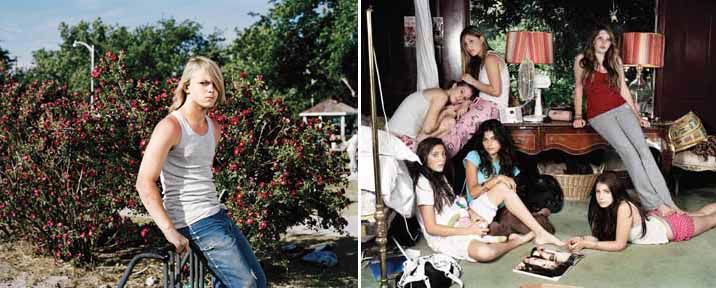Seven Questions for Danielle Levitt
Danielle Levitt came to New York from LA and began photographing the downtown hipster scene in the mid-1990s. Her street fashions first showed up in The New York Post. Now her highly structured photographs of celebrities and art stars are seen in magazines like Rolling Stone and The New York Times Magazine, and in ads for Target and Nike. Her first book, We Are Experienced, in which she criss-crossed the country photographing teens from all kinds of backgrounds, is being launched tomorrow night in New York, at Deitch Projects. I caught up with Danielle yesterday by phone to find out more.
Peggy Roalf: With all the posing and posturing that's part of being a teen, how did you get these kids to get real? Many of them seem to have completely dropped their guard.
Danielle Levitt: Being in their space and with the camera and lighting is a little disarming for them at first. Toward the end of the shoot, it's more relaxed. I mean, here's a woman closer in age to their parents but more like a peer in attitude. So they realize that I'm there to celebrate them.

Images from We Are Experienced by Danielle Levitt, A Miss Rosen Edition, published by powerHouse Books; introduction and interview by Marc Jacobs.
PR: Did most of your subjects know that you shoot a lot of celebrities and did they ask you about this?
DL: I was able to use this to get their trust. Shooting celebs, like 50 Cent or Rianna, was a plus because this is a huge part of their life. It legitimized me and gave me entry and I'm so thankful for that. It's fascinating - I found that kids don't really know how much they influence celebrities There's a cross-pollination that goes from the street up.
PR: You mean, Mary Kate Olsen wouldn't be in Vogue if it weren't for these kids? By the way, did you find that many of the kids look at magazines?
DL: The kids that i shot don't typically look in magazines. Most of them live away from big cities, so they get a suburban, Barnes & Noble type of exposure. They receive the bulk of their information through the Internet. There are now so many ways to view celebs, the perhaps the quickest and most affordable, are through web fan sites.
PR: Looking through the book, I found it harder to "get" the more mainstream kids, like the frat party, the kids with their dogs, the snowboarders. Was it easier or harder to get them to show their true selves?
DL: The "normal" kids are the hardest ones because their style and behavior is so familiar to us. But Twiggy [in Basehor, Kansas] is all out front. His raver style elements make the portrait strange and quirky. The kids with their dogs, who live on this horse farm in Lexington, Kentucky lead a normal life. Outside of their riding clothes they don't have much in the way of signifiers. Their style is more subtle and it takes more dissection to see that these are people who identify in a way with mainstream stuff.
When shooting the mainstream kids, I really placed emphasis on the group dynamic. As independents, their style, while cool, does not immediately allow the viewer to understand them or their interests. By presenting photos of many teens identifying in the same fashion, we learn how like types gather.
The whole idea of getting more normative kids in groups, like the girls in the bedroom in LA - this shows an archetypal relationship between BFFs - best friends forever. You can see that these are the cool girls who run in a clique. These girls are totally committed to being girls and you see the signifiers like the diet poster, the fashion magazine, the kind of things that embody what we see in the movies.
PR: What about the hunter in Roscoe, New York?
DL: I found that the more eccentric kids had more of a draw for me because they offer an entry point to their passion, like the hunter. This is a guy who, with his friends, is totally committed to being a hunter. I mean, they go into the woods in zero degree weather and sit in trees! He just graduated and his girlfriend is still in high school. In this picture, he's come back home for Thanksgiving. He's so calm, so settled; she seems to have questions to be answered.
PR: How do you set up a shoot?
DL: I like to photograph what they want to give me, in places they choose. In the Flagstaff shoot, at a summer camp where the dorm rooms had been emptied out, these girls were not part of the cool crowd, they didn't have the luxuries some of the others did, but they were the ones who held my attention. I like to discover their process, and watch how they negotiate the shoot - in this case, the process gave them more confidence. They enter the process and within it they change somewhat.
PR: What's up next for you?
DL: More teens! I want to hang out with them, I want to see them in sort of the hyper-realistic version of themselves, going out at night where there's a greater emphasis on expressing themselves. I never get bored with finding out how they process information and negotiate how all this stuff that draws them will trickle down into their lives.
powerHouse Books and Deitch Projects are pleased to invite DART subscribers to the launch of We Are Experienced by Danielle Levitt, Wednesday, October 29, from 7:00 to 9:00 pm. 76 Grand Street, NYC. 212.343.7300.


